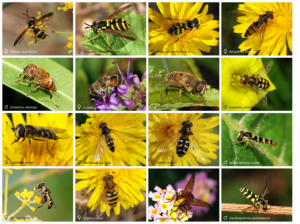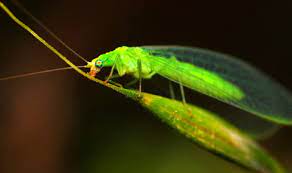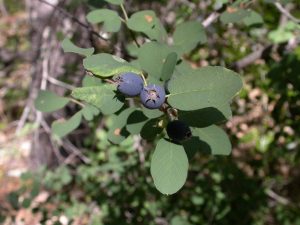 Despite being named Oregon State Gardener of the Year last year in 2023, my front yard is a constant embarrassment to me. It is NOT like the other, “well-tended” yards in my neighborhood. It is weedy and rangy and has dead stems and flower stalks all over it. Dry leaves are piled up under all the shrubs and trees. I even have what we refer to as a ‘dragon nest’- a structure I made from with woody debris from coppicing my hazelnuts, red twig dogwood, and serviceberry. I wove these materials into a wattle compost container. This holds other woody debris and leaves in a brush pile. All of these have been deliberately left – as messy as they are – to support insect life and the birds that come to feed upon them.
Despite being named Oregon State Gardener of the Year last year in 2023, my front yard is a constant embarrassment to me. It is NOT like the other, “well-tended” yards in my neighborhood. It is weedy and rangy and has dead stems and flower stalks all over it. Dry leaves are piled up under all the shrubs and trees. I even have what we refer to as a ‘dragon nest’- a structure I made from with woody debris from coppicing my hazelnuts, red twig dogwood, and serviceberry. I wove these materials into a wattle compost container. This holds other woody debris and leaves in a brush pile. All of these have been deliberately left – as messy as they are – to support insect life and the birds that come to feed upon them.
Leaving the leaves, as the Xerces Society advocates, has much to recommend it. Leaves provide winter cover for small invertebrates and insects who help break down the carbon in the leaf mulch and return nutrients to the soil in the form of their waste. Soil bacteria break down those waste products further to provide nutrients that plants and mycorrhizal fungi can then access. Soil under leaves is rich in carbon, nutrients, soil life, and holds moisture longer, allowing plants to access all. Winter birds forage in this rich mix and find critical food during the coldest months.
While I am not above feeling guilty about how my yard appears, I still persist. Because I know that neatly mown, raked and leaf blown yards provide none of this forage and none of these soil services. So, while my neighbors think they are being good citizens, they are merely addressing the eye candy that humans have been trained to look for in our managed landscapes. Nature is never considered. And nature pays the price.
 I have 39 species of birds that visit my pitifully small corner lot in Medford. There they find winter seed heads to feed from, leaves to dig through to find isopods, overwintering fly, moth and butterfly larvae, earthworms, centipedes, millipedes, and other winter food. I do not see this activity in or on any of the other yards in my neighborhood. The flower stems and stalks of the perennials, though blackened and bent from winter storms, are home to stem nesting native bees, which can also provide larvae to birds who drill into the stems for food. Lizards and snakes can safely shed their skins and find winter hibernation spots under the wood chips, pine bark and small logs I place under my shrubs. Toads and salamanders will often find homes under decomposing wood piles and logs placed strategically under shrubbery.
I have 39 species of birds that visit my pitifully small corner lot in Medford. There they find winter seed heads to feed from, leaves to dig through to find isopods, overwintering fly, moth and butterfly larvae, earthworms, centipedes, millipedes, and other winter food. I do not see this activity in or on any of the other yards in my neighborhood. The flower stems and stalks of the perennials, though blackened and bent from winter storms, are home to stem nesting native bees, which can also provide larvae to birds who drill into the stems for food. Lizards and snakes can safely shed their skins and find winter hibernation spots under the wood chips, pine bark and small logs I place under my shrubs. Toads and salamanders will often find homes under decomposing wood piles and logs placed strategically under shrubbery.
As I went to collect the mail yesterday, I thought, “I had better do some clean-up along the sidewalk and the gutter.” But then I realized that all along the edge of my yard, the leaves had been scraped hectically onto the sidewalk as robins and flickers foraged through them. Each small dark scrape in the leaf litter represented a bird that had been fed by my yard. I resolutely left the leaves where they were in the gutter and on the sidewalk and came inside to write this article instead.
Leaves are not LITTER. Leaves are HABITAT.
Change your view of gardening, and GARDEN FOR LIFE!
For more resources and information visit the Xerces site listed here: Leave the Leaves!

 While most gardeners think of planting new garden plants in spring when the weather warms, the very best time to plant those native plants you’ve been meaning to put in is fall. Autumn planting of natives has many benefits for the gardener, the plants and the soil. Our native plant nursery at Southern Oregon Research and Extension Center has many beautiful native grasses, perennials, shrubs and trees for you to plant in late October for establishment over the winter months. And as an added bonus, we will be selling them on Saturday, October 14th from 9 am to 2 pm. Yes, this is shameless self-promotion, but we want EVERYONE to plant a native this fall!
While most gardeners think of planting new garden plants in spring when the weather warms, the very best time to plant those native plants you’ve been meaning to put in is fall. Autumn planting of natives has many benefits for the gardener, the plants and the soil. Our native plant nursery at Southern Oregon Research and Extension Center has many beautiful native grasses, perennials, shrubs and trees for you to plant in late October for establishment over the winter months. And as an added bonus, we will be selling them on Saturday, October 14th from 9 am to 2 pm. Yes, this is shameless self-promotion, but we want EVERYONE to plant a native this fall!


 In September of 2021, the irrigation wells on the OSU Southern Oregon Research and Education Center campus in Central Point ran dry. Watering of all campus demonstration gardens stopped, and plants in the native plant nursery began to die. Through a massive emergency effort, the nursery stock was either donated to local restoration projects or taken to member homes to be maintained until we could install a watering system.
In September of 2021, the irrigation wells on the OSU Southern Oregon Research and Education Center campus in Central Point ran dry. Watering of all campus demonstration gardens stopped, and plants in the native plant nursery began to die. Through a massive emergency effort, the nursery stock was either donated to local restoration projects or taken to member homes to be maintained until we could install a watering system. approval to install the rain catchment system as an emergency irrigation backup for our well. Fundraising began for the $15,000 system with a Go Fund Me campaign in February of 2022. A total of $10,367 was raised, with the remaining funds being acquired through plant sales from the native plant nursery, and a generous grant from
approval to install the rain catchment system as an emergency irrigation backup for our well. Fundraising began for the $15,000 system with a Go Fund Me campaign in February of 2022. A total of $10,367 was raised, with the remaining funds being acquired through plant sales from the native plant nursery, and a generous grant from  rainwater to maintain the native plants in the nursery on campus in the event of another well failure. Additionally, the system will serve as a demonstration teaching tool for Master Gardeners, Small Farms, Land Stewards, 4-H programs, and any community association that would like to bring members onto campus to see what a large capacity capture system looks like. An interpretive sign was installed in early July of 2023, and we look forward to the public being able to learn about rainwater catchment on the SOREC campus.
rainwater to maintain the native plants in the nursery on campus in the event of another well failure. Additionally, the system will serve as a demonstration teaching tool for Master Gardeners, Small Farms, Land Stewards, 4-H programs, and any community association that would like to bring members onto campus to see what a large capacity capture system looks like. An interpretive sign was installed in early July of 2023, and we look forward to the public being able to learn about rainwater catchment on the SOREC campus.
 Back in April you read Part 1 of this series about beneficial insects you can encourage in your yards. I discussed predatory insects: lacewings, mantids, ladybird beetles, pirate bugs and syrphid flies. All of these are active hunters of garden pests. Now we need to shift our focus to the parasitoids – those insects who parasitize other insects. In this instance, females of the parasite find a suitable host insect – usually a caterpillar – and lay their eggs directly in the body of the host. The host remains alive while being eaten from the inside by the larvae of the parasite. Not a pleasant vision, but one uniquely designed by nature to maintain ecosystem balance. Examples of parasitoids are parasitic tachinid flies, braconid, chalcid, Ichneumonid and trichogramma wasps.
Back in April you read Part 1 of this series about beneficial insects you can encourage in your yards. I discussed predatory insects: lacewings, mantids, ladybird beetles, pirate bugs and syrphid flies. All of these are active hunters of garden pests. Now we need to shift our focus to the parasitoids – those insects who parasitize other insects. In this instance, females of the parasite find a suitable host insect – usually a caterpillar – and lay their eggs directly in the body of the host. The host remains alive while being eaten from the inside by the larvae of the parasite. Not a pleasant vision, but one uniquely designed by nature to maintain ecosystem balance. Examples of parasitoids are parasitic tachinid flies, braconid, chalcid, Ichneumonid and trichogramma wasps. Tachinid flies are quite variable in appearance but are usually very bristly. Adult flies feed on nectar and are important pollinators in your garden.
Tachinid flies are quite variable in appearance but are usually very bristly. Adult flies feed on nectar and are important pollinators in your garden. Female flies lay one to several eggs in a host caterpillar or similar larva. Those eggs then hatch and the fly larvae feed on the living host until they are ready to pupate, at which point they emerge, finally killing the host insect.
Female flies lay one to several eggs in a host caterpillar or similar larva. Those eggs then hatch and the fly larvae feed on the living host until they are ready to pupate, at which point they emerge, finally killing the host insect.


 wasps – like a speck of dust. Females lay up to 300 eggs, usually in the eggs of the host insect. But some also lay eggs directly into the bodies of adult scale, aphids, beetles, psyllids and caterpillars such as cutworms, hornworms, corn earworms, and leafrollers. Trichogramma wasps can be purchased in nurseries and organic growing supply stores.
wasps – like a speck of dust. Females lay up to 300 eggs, usually in the eggs of the host insect. But some also lay eggs directly into the bodies of adult scale, aphids, beetles, psyllids and caterpillars such as cutworms, hornworms, corn earworms, and leafrollers. Trichogramma wasps can be purchased in nurseries and organic growing supply stores.

 Chalcid wasps parasitize caterpillars of several different species, while
Chalcid wasps parasitize caterpillars of several different species, while Ichneumonid wasps specialize primarily in tree pest insects. Chalcid, Braconid and Icneumonid wasps are much larger than Trichogramma and parasitize caterpillars directly.
Ichneumonid wasps specialize primarily in tree pest insects. Chalcid, Braconid and Icneumonid wasps are much larger than Trichogramma and parasitize caterpillars directly. Lacewings & Snakeflies
Lacewings & Snakeflies Our second most important pollinators are the flies. Larvae eat garden pest species, while the adults are nectar feeders on small, shallow flowers in the Brassicaceae, Apiaceae, and Asteraceae families.
Our second most important pollinators are the flies. Larvae eat garden pest species, while the adults are nectar feeders on small, shallow flowers in the Brassicaceae, Apiaceae, and Asteraceae families. True bugs – Minute Pirate bug, Big-Eyed Bug and Damsel Bug
True bugs – Minute Pirate bug, Big-Eyed Bug and Damsel Bug Beetles: Ladybug, Rove Beetle, Soldier Beetle, and Ground Beetle.
Beetles: Ladybug, Rove Beetle, Soldier Beetle, and Ground Beetle. Did you miss the Spring Garden Fair on May 6th at Southern Oregon Research and Extension Center?
Did you miss the Spring Garden Fair on May 6th at Southern Oregon Research and Extension Center?

 Vaccinium ovatum Pursh
Vaccinium ovatum Pursh Rubus nutkanus Moc. ex Ser.
Rubus nutkanus Moc. ex Ser. Rosa nutkana C. Presl
Rosa nutkana C. Presl uneatus
uneatus Amelanchier alnifolia (Nutt.) Nutt. ex M. Roem.
Amelanchier alnifolia (Nutt.) Nutt. ex M. Roem. Crataegus douglasii Lindl.
Crataegus douglasii Lindl. Corylus cornuta Marshall
Corylus cornuta Marshall
 Oregon State University Extension
Oregon State University Extension
